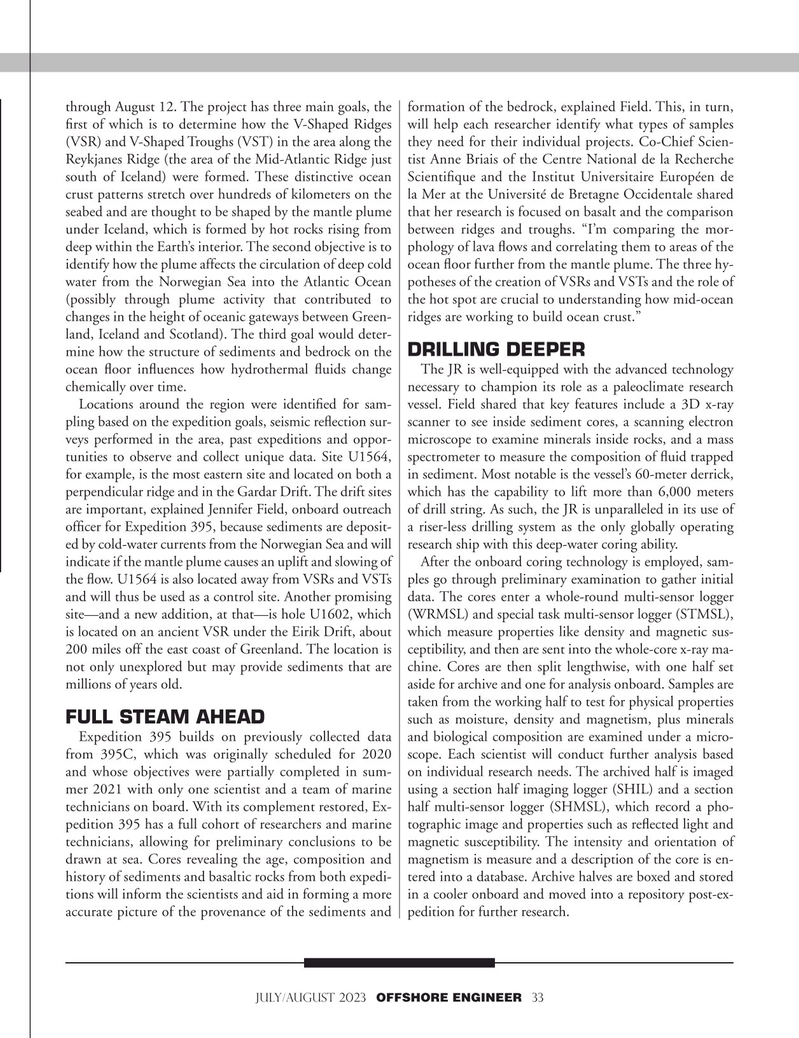
Page 33: of Offshore Engineer Magazine (Jul/Aug 2023)
Read this page in Pdf, Flash or Html5 edition of Jul/Aug 2023 Offshore Engineer Magazine
through August 12. The project has three main goals, the formation of the bedrock, explained Field. This, in turn, frst of which is to determine how the V-Shaped Ridges will help each researcher identify what types of samples (VSR) and V-Shaped Troughs (VST) in the area along the they need for their individual projects. Co-Chief Scien-
Reykjanes Ridge (the area of the Mid-Atlantic Ridge just tist Anne Briais of the Centre National de la Recherche south of Iceland) were formed. These distinctive ocean Scientifque and the Institut Universitaire Européen de crust patterns stretch over hundreds of kilometers on the la Mer at the Université de Bretagne Occidentale shared seabed and are thought to be shaped by the mantle plume that her research is focused on basalt and the comparison under Iceland, which is formed by hot rocks rising from between ridges and troughs. “I’m comparing the mor- deep within the Earth’s interior. The second objective is to phology of lava fows and correlating them to areas of the identify how the plume affects the circulation of deep cold ocean foor further from the mantle plume. The three hy- water from the Norwegian Sea into the Atlantic Ocean potheses of the creation of VSRs and VSTs and the role of (possibly through plume activity that contributed to the hot spot are crucial to understanding how mid-ocean changes in the height of oceanic gateways between Green- ridges are working to build ocean crust.” land, Iceland and Scotland). The third goal would deter-
DRILLING DEEPER mine how the structure of sediments and bedrock on the ocean foor infuences how hydrothermal fuids change The JR is well-equipped with the advanced technology chemically over time. necessary to champion its role as a paleoclimate research
Locations around the region were identifed for sam- vessel. Field shared that key features include a 3D x-ray pling based on the expedition goals, seismic refection sur- scanner to see inside sediment cores, a scanning electron veys performed in the area, past expeditions and oppor- microscope to examine minerals inside rocks, and a mass tunities to observe and collect unique data. Site U1564, spectrometer to measure the composition of fuid trapped for example, is the most eastern site and located on both a in sediment. Most notable is the vessel’s 60-meter derrick, perpendicular ridge and in the Gardar Drift. The drift sites which has the capability to lift more than 6,000 meters are important, explained Jennifer Field, onboard outreach of drill string. As such, the JR is unparalleled in its use of offcer for Expedition 395, because sediments are deposit- a riser-less drilling system as the only globally operating ed by cold-water currents from the Norwegian Sea and will research ship with this deep-water coring ability. indicate if the mantle plume causes an uplift and slowing of After the onboard coring technology is employed, sam- the fow. U1564 is also located away from VSRs and VSTs ples go through preliminary examination to gather initial and will thus be used as a control site. Another promising data. The cores enter a whole-round multi-sensor logger site—and a new addition, at that—is hole U1602, which (WRMSL) and special task multi-sensor logger (STMSL), is located on an ancient VSR under the Eirik Drift, about which measure properties like density and magnetic sus- 200 miles off the east coast of Greenland. The location is ceptibility, and then are sent into the whole-core x-ray ma- not only unexplored but may provide sediments that are chine. Cores are then split lengthwise, with one half set millions of years old. aside for archive and one for analysis onboard. Samples are taken from the working half to test for physical properties such as moisture, density and magnetism, plus minerals
FULL STEAM AHEAD
Expedition 395 builds on previously collected data and biological composition are examined under a micro- from 395C, which was originally scheduled for 2020 scope. Each scientist will conduct further analysis based and whose objectives were partially completed in sum- on individual research needs. The archived half is imaged mer 2021 with only one scientist and a team of marine using a section half imaging logger (SHIL) and a section technicians on board. With its complement restored, Ex- half multi-sensor logger (SHMSL), which record a pho- pedition 395 has a full cohort of researchers and marine tographic image and properties such as refected light and technicians, allowing for preliminary conclusions to be magnetic susceptibility. The intensity and orientation of drawn at sea. Cores revealing the age, composition and magnetism is measure and a description of the core is en- history of sediments and basaltic rocks from both expedi- tered into a database. Archive halves are boxed and stored tions will inform the scientists and aid in forming a more in a cooler onboard and moved into a repository post-ex- accurate picture of the provenance of the sediments and pedition for further research. july/august 2023 OFFSHORE ENGINEER 33

 32
32

 34
34